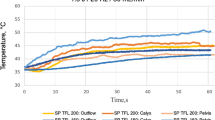Abstract
Purpose
Holmium:YAG laser is the most used laser for urolithiasis. Generally, we use metallic scissors to cut the fiber tip to restore its effectiveness. Many cleaving methods have been described to avoid fiber damage and to restore its greatest power to the fiber. There is a lack of information regarding which cleaving method should be used and its effect on the fiber. In order to compare these effects, we studied different cleavage methods in terms of power output and its effects on the fiber.
Methods
New single-use 272-μm fibers were used with a holmium:YAG laser lithotripter. Five kinds of fiber tips were compared: a new intact fiber, cleaved with ceramic scissors, cleaved with metallic scissors, first cleaved then stripped and first stripped then cleaved. The fibers were used against synthetic stones (BegoStone®) similar to calcium oxalate monohydrate, with fragmentation (SP, 5 Hz, 1.5 J) and dusting (LP, 15 Hz, 0.5 J) settings. We measured power output at 0, 1, 5, 10 and 15 min.
Results
For fragmentation parameters, there was a statistical difference between the 5 groups at 0 and 1 min of laser use (p < 0.05) and none for time period over 1 min (p = 0.077–0.658). For dusting parameters, there was a statistical difference between the 5 groups at 0 min of laser use (p < 0.05) and none for time period over 0 min (p = 0.064–1).
Conclusion
Cleaving the fiber tip may restore its effectiveness to the fiber, but only for a limited time, although it may preserve the scopes from damage.


Similar content being viewed by others
References
Kronenberg P, Traxer O (2014) Update on lasers in urology 2014: current assessment on holmium:yttrium-aluminum-garnet (Ho:YAG) laser lithotripter settings and laser fibers. World J Urol 33(4):463–469
Vicente Rodríguez J, Fernández González I, Hernández Fernández C, Santos García-Vaquero I, Rosales Bordes A (2006) Lasers in urology. Actas Urol Esp 30(9):879–895
Mues AC, Teichman JMH, Knudsen BE (2009) Quantification of holmium:yttrium aluminum garnet optical tip degradation. J Endourol Endourol Soc 23(9):1425–1428
Khemees TA, Shore DM, Antiporda M, Teichman JMH, Knudsen BE (2013) Evaluation of a new 240-μm single-use holmium:YAG optical fiber for flexible ureteroscopy. J Endourol 27(4):475–479
Kronenberg P, Traxer O (2015) Are we all doing it wrong? Influence of stripping and cleaving methods of laser fibers on laser lithotripsy performance. J Urol 193(3):1030–1035
Peplinski B, Faaborg D, Miao E, Alsyouf M, Myklak K, Kelln W et al (2016) The effect of laser fiber cleave technique and lithotripsy time on power output. J Endourol 30(6):678–684
Esch E, Simmons WN, Sankin G, Cocks HF, Preminger GM, Zhong P (2010) A simple method for fabricating artificial kidney stones of different physical properties. Urol Res 38(4):315–319
Yunbo Liu PZ (2002) BegoStone—a new stone phantom for shock wave lithotripsy research (L). J Acoust Soc Am 112(4):1265–1268
Sea J, Jonat LM, Chew BH, Qiu J, Wang B, Hoopman J et al (2012) Optimal power settings for Holmium:YAG lithotripsy. J Urol 187(3):914–919
Kronenberg P, Traxer O (2014) In vitro fragmentation efficiency of holmium: yttrium-aluminum-garnet (YAG) laser lithotripsy—a comprehensive study encompassing different frequencies, pulse energies, total power levels and laser fibre diameters. BJU Int 114(2):261–267
Giusti G, Proietti S, Villa L, Cloutier J, Rosso M, Gadda GM et al (2016) Current standard technique for modern flexible ureteroscopy: tips and tricks. Eur Urol 70(1):188–194
Vassantachart JM, Lightfoot M, Yeo A, Maldonado J, Li R, Alsyouf M et al (2015) Laser fiber cleaving techniques: effects on tip morphology and power output. J Endourol Endourol Soc 29(1):84–89
From Cook Medical”Fiber cleaving tool” brochure. Visited on July 2016 [Internet]. Available from: https://www.cookmedical.com/data/IFU_PDF/T_FCT_REV2.PDF
Mues AC, Teichman JMH, Knudsen BE (2009) Evaluation of 24 Holmium:YAG laser optical fibers for flexible ureteroscopy. J Urol 182(1):348–354
Akar EC, Knudsen BE (2015) Evaluation of 16 new holmium: yttrium-aluminum-garnet laser optical fibers for ureteroscopy. Urology 86(2):230–235
Acknowledgements
Mattieu Haddad is supported by the AFU scholarship from the French Association of Urology. Esteban Emiliani is supported by the EUSP scholarship program from the European Association of Urology.
Author information
Authors and Affiliations
Contributions
Protocol/project development was by M. Haddad and O. Traxer. Data collection or management was by M. Haddad Y. Rouchausse, F. Coste and L. Berthe. Data analysis was done by M. Haddad and S. Buttice. Manuscript writing/editing was by M. Haddad, E. Emiliani, S. Doizi and B. Somani.
Corresponding author
Ethics declarations
Conflict of interest
Prof. O. Traxer is a consultant for Olympus, Rocamed, Coloplast and Boston Scientific. The rest of the authors declare that they do not have conflicts of interest.
Funding
None.
Electronic supplementary material
Below is the link to the electronic supplementary material.
Rights and permissions
About this article
Cite this article
Haddad, M., Emiliani, E., Rouchausse, Y. et al. Impact of laser fiber tip cleavage on power output for ureteroscopy and stone treatment. World J Urol 35, 1765–1770 (2017). https://doi.org/10.1007/s00345-017-2053-1
Received:
Accepted:
Published:
Issue Date:
DOI: https://doi.org/10.1007/s00345-017-2053-1




